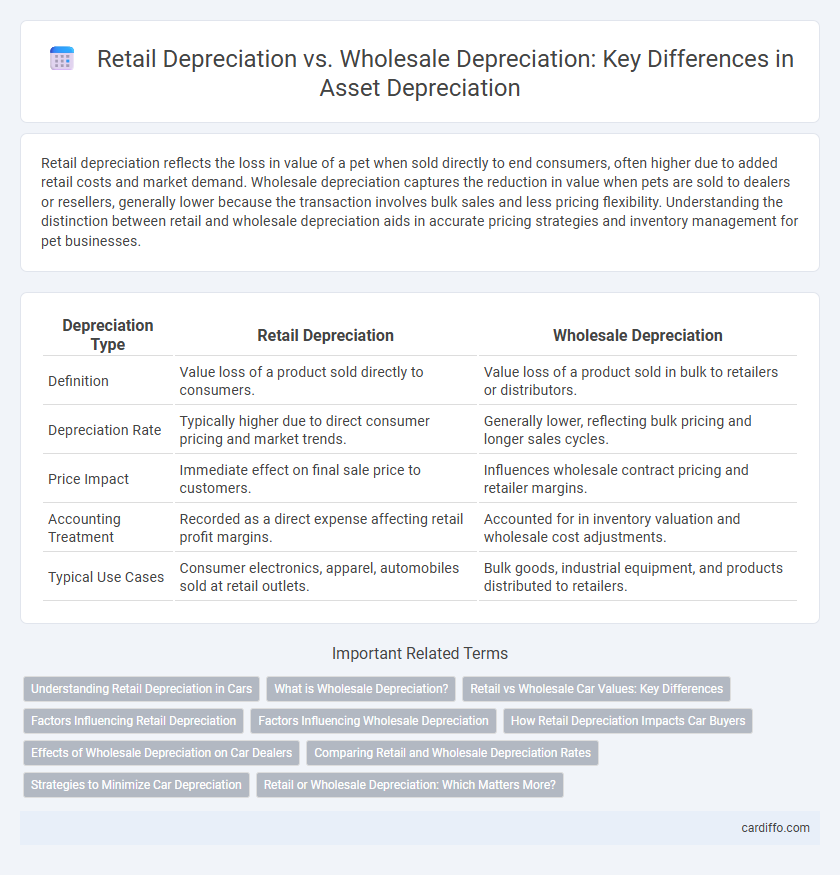Retail depreciation reflects the loss in value of a pet when sold directly to end consumers, often higher due to added retail costs and market demand. Wholesale depreciation captures the reduction in value when pets are sold to dealers or resellers, generally lower because the transaction involves bulk sales and less pricing flexibility. Understanding the distinction between retail and wholesale depreciation aids in accurate pricing strategies and inventory management for pet businesses.
Table of Comparison
| Depreciation Type | Retail Depreciation | Wholesale Depreciation |
|---|---|---|
| Definition | Value loss of a product sold directly to consumers. | Value loss of a product sold in bulk to retailers or distributors. |
| Depreciation Rate | Typically higher due to direct consumer pricing and market trends. | Generally lower, reflecting bulk pricing and longer sales cycles. |
| Price Impact | Immediate effect on final sale price to customers. | Influences wholesale contract pricing and retailer margins. |
| Accounting Treatment | Recorded as a direct expense affecting retail profit margins. | Accounted for in inventory valuation and wholesale cost adjustments. |
| Typical Use Cases | Consumer electronics, apparel, automobiles sold at retail outlets. | Bulk goods, industrial equipment, and products distributed to retailers. |
Understanding Retail Depreciation in Cars
Retail depreciation in cars measures the value loss from the consumer's purchase price compared to the new vehicle price, reflecting market demand and retail dealer pricing strategies. It typically represents a higher cost to the buyer because retail prices include dealer markups, reconditioning fees, and overhead costs, resulting in slower depreciation than wholesale values. Understanding this distinction helps buyers gauge true vehicle value and anticipate future resale or trade-in prices effectively.
What is Wholesale Depreciation?
Wholesale depreciation refers to the reduction in value of a vehicle or asset when sold through wholesale channels, typically involving auctions or dealer-to-dealer transactions, which usually results in lower prices than retail sales. Unlike retail depreciation, which considers the price a consumer pays including dealer markup and reconditioning costs, wholesale depreciation reflects the asset's value based on its wholesale market demand and condition. Understanding wholesale depreciation is crucial for businesses managing fleet resale or inventory turnover to maximize residual value.
Retail vs Wholesale Car Values: Key Differences
Retail depreciation reflects the value loss of a vehicle when sold directly to consumers, typically resulting in higher prices due to dealer markup and added services. Wholesale depreciation captures the value decline in vehicles sold between dealers or at auctions, usually reflecting lower prices as vehicles are sold in bulk or "as-is." Understanding these differences helps sellers optimize timing and pricing strategies based on target market segments and transaction types.
Factors Influencing Retail Depreciation
Retail depreciation is significantly influenced by factors such as consumer demand, vehicle condition, mileage, and market trends, which directly affect a car's resale value in the retail market. Seasonal demand fluctuations, regional preferences, and the presence of certified pre-owned programs also play crucial roles in determining retail depreciation rates. These factors differentiate retail depreciation from wholesale depreciation, where wholesale values are more impacted by dealer-to-dealer transactions and auction prices.
Factors Influencing Wholesale Depreciation
Wholesale depreciation is primarily influenced by factors such as vehicle age, mileage, overall condition, and market demand among dealerships. Economic conditions and manufacturer incentives also significantly affect wholesale prices, often leading to steeper depreciation compared to retail values. Seasonal trends and regional variations further contribute to fluctuations in wholesale depreciation rates.
How Retail Depreciation Impacts Car Buyers
Retail depreciation significantly affects car buyers by reducing the resale value of vehicles more rapidly compared to wholesale depreciation. This accelerated loss in value results from factors like dealership markups, retail demand fluctuations, and added retail services that are factored into the purchase price. Understanding retail depreciation helps buyers make informed decisions about total cost of ownership and timing for vehicle replacement.
Effects of Wholesale Depreciation on Car Dealers
Wholesale depreciation significantly impacts car dealers by reducing their profit margins when selling used vehicles at auctions. As wholesale prices drop, dealers often face higher holding costs and increased pressure to lower retail prices to move inventory. This dynamic can constrain dealership cash flow and affect overall dealership profitability.
Comparing Retail and Wholesale Depreciation Rates
Retail depreciation rates typically exceed wholesale depreciation rates due to higher overhead costs and profit margins factored into retail pricing. Wholesale depreciation reflects the asset's decline in value closer to its intrinsic worth, as it excludes retail markups and maintains a more direct correlation to market demand. Analyzing these rates reveals how resale channels impact asset value and informs pricing strategies for used goods.
Strategies to Minimize Car Depreciation
Retail depreciation typically exceeds wholesale depreciation as retail values include dealer markups and retail demand factors. Strategies to minimize car depreciation focus on maintaining comprehensive service records, selecting high-resale-value models, and avoiding excessive customization that limits buyer appeal. Regular maintenance and choosing vehicles with strong brand reputations also help preserve retail value longer than wholesale value.
Retail or Wholesale Depreciation: Which Matters More?
Wholesale depreciation typically reflects the faster and deeper loss in value as products move off the manufacturer's floor, while retail depreciation factors in market demand and consumer perception, often resulting in slower value decline. Retail depreciation matters more for end consumers and retailers because it directly impacts resale prices, profit margins, and inventory turnover. Wholesale depreciation is crucial for manufacturers and distributors managing bulk sales and supply chain valuation but less relevant to market price adjustments.
Retail Depreciation vs Wholesale Depreciation Infographic

 cardiffo.com
cardiffo.com